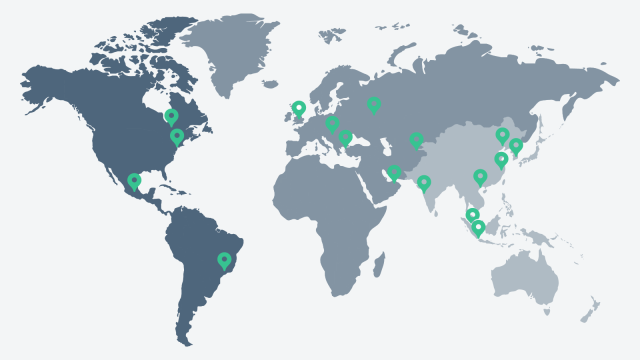With its customer-oriented business model Landesbank Baden-Württemberg (LBBW) successfully continued its earnings performance in 2016 in its operating business despite a difficult market setting. Based on preliminary figures, the Bank generated a profit before tax and goodwill impairment of EUR 521 million after EUR 531 million in the previous year. This means that LBBW met the expectations it announced at the start of the year.
Customer-oriented business model proves its worth in a challenging market setting Net interest income almost stable despite low interest rates, net fee and commission income higher than previous year Profit before tax and before goodwill impairment almost at prior-year level at EUR 521 million, as expected Full goodwill impairment mainly due to the persistent low level of interest rates This led to a decline in profit before tax pursuant to IFRS to EUR 142 million, however, it has no impact on the HGB result and on LBBW's capital ratios High forward-looking investment in IT and restructuring expenses Capitalization remains excellent: Common Equity Tier 1 capital ratio of 15.2 percent and total capital ratio of 21.5 percent (according to CRR/CRD IV fully loaded)
The profit figure is weighed down by the full impairment of goodwill amounting to EUR 379 million that was almost exclusively due to the takeover of former Sachsen LB in 2008 and that has an impact solely pursuant to IFRS accounting. The impairment became necessary due to the weaker earnings prospects for the banking sector in the corporate customer business, particularly as a result of the historically low interest rates. Due to the full impairment of goodwill, the IFRS-based profit before tax came to EUR 142 million. LBBW now no longer has any goodwill on the balance sheet. Rainer Neske, Chairman of LBBW's Board of Managing Directors: "Our performance in the operating business shows the high level of trust our customers place in us during uncertain times. This is due to our long-standing business relationships and to our excellent capitalization, which reflects our stability as a bank." Commenting on the impairment of goodwill, Neske stated: "We are performing the required write-down from a position of strength. It has no impact on our capital ratios. Thanks to this measure, we are even better equipped to hold our own in a challenging market setting. We will once again focus more strongly on profitable growth with our customers while at the same time increasing our cost discipline." LBBW's customer business reported a respectable performance overall in 2016, given the demanding underlying conditions. Thus the Bank raised its loan volume in business with large corporates and groups by around EUR 2 billion to some EUR 12.5 billion, while also increasing its loan portfolio for commercial real estate customers by around 2 billion to approx. EUR 23 billion. Due to the expansion of the financing business, among other things, total assets rose to EUR 244 billion as at 31 December 2016, up from EUR 234 billion in the previous year. LBBW also expanded its position in capital market-related financing solutions and the financing of company takeovers. In 2016, LBBW once again came top in terms of promissory note (Schuldschein) transactions with a total of 43 issues and an overall volume of EUR 10.7 billion. It also featured once again among the prime names in the syndicate loan business in Germany. Thanks to its execution capacity, the Bank expanded its activities with both companies and institutional customers seeking to broaden their funding base. Corporate customers, institutional customers and private customers alike attach great importance to reliable banking partners with a strong capital base. LBBW meets these requirements thanks to an extremely comfortable capitalization. As at 31 December 2016 all capital ratios substantially exceeded regulatory requirements: the Common Equity Tier 1 (CET 1) capital ratio based on currently applicable supervisory law (CRR/CRD IV with transitional rules) was 15.5 percent at year-end. Subject to full application of CRR/CRD IV (fully loaded), which will not come into effect until 2019, it came to 15.2 percent. The total capital ratio amounted to 21.7 percent under CRR/CRD IV with transitional rules and to 21.5 percent on a CRR/CRD IV fully loaded basis. With a leverage ratio of 4.6 percent according to CRR/CRD IV fully loaded, LBBW easily exceeds the minimum level of 3 percent stipulated by the regulator. Overview of expense and income items Net interest income benefited from a slight increase in lending to customers and remained almost stable despite historically low interest rates. It came to EUR 1 624 million, after EUR 1 654 million in 2015. Allowances for losses on loans and advances were EUR 51 million, down from EUR 55 million in 2015. Due to the balanced risk policy and persistently favorable state of the economy in the core markets, the provisioning requirement remained well below the long-term average. Net fee and commission income improved from EUR 515 million to EUR 527 million. Supported by LBBW's strong position in capital market issues and the custodian business, the securities and deposit business in particular showed a gratifying performance. Moreover, income from payment transactions rose through cooperations in the credit card business. Net gains/losses from financial instruments measured at fair value through profit or loss fell from EUR 209 million in the previous year to EUR 190 million. Strain resulted from the measurement of hedging derivatives, which under IFRS could not be included in hedge accounting. Net gains/losses from financial investments and net income/expenses from investments accounted for using the equity method rose substantially from EUR 94 million to EUR 195 million. As we already reported on in the first halfyear, this increase was partly due to the investment income generated from the sale of the subsidiary cellent AG and the shares in VISA Europe Limited. In addition, securities sales made a positive contribution to earnings. Administrative expenses were marked by high spending on IT and forward-looking projects such as the switch to a new core banking system. But thanks to strict cost discipline, at EUR 1 814 million they remained almost at the pre-year level (EUR 1 782 million). Expenses for the bank levy and deposit guarantee system stood at EUR 71 million. The Bank paid a guarantee commission for the risk shield of the State of Baden-Württemberg amounting to EUR 93 million. The restructuring result of minus EUR 87 million includes expenses incurred in the course of projects to streamline business processes and the product range, such as the realignment of the capital markets business and the reorganization of the back office. In 2016 LBBW reported impairment of goodwill amounting to EUR 379 million. The impairment test at year-end 2016 led to a full write-down of the goodwill allocated to the Corporates segment due to changed underlying conditions. The goodwill resulted almost exclusively from the acquisition of Sachsen LB in 2008. The lower estimate of future earnings potential is based mainly on the low level of interest rates, the intense competition especially in the SME business, muted demand for loans, rising regulatory charges and modest growth projections for the economy as a whole. The write-down did not result in a burden on the Group's capital ratios. All told, the preliminary IFRS consolidated profit before tax for the past year works out to EUR 142 million. IFRS net consolidated profit after tax comes to EUR 11 million. Pursuant to HGB accounting , LBBW generated net profit/loss for the year before tax of EUR 269 million (previous year EUR 385 million) and net profit/loss for the year after tax of EUR 219 million (previous year: EUR 322 million). The above-mentioned impairment of goodwill does not have an impact on the HGB result and thus on the payout to the owners. The Board of Managing Directors will propose to the Annual General Meeting a payout of EUR 219 million. Overview of the operating segments The non-recurring effect described above and the investments weighed on the three operating segments Corporates, Financial Markets and Retail/Savings Banks, in particular. Thanks to a solid customer business performance overall, however, they made a substantially positive contribution to earnings of EUR 316 million. The Corporates segment generated satisfactory earnings before goodwill of EUR 630 million in a difficult market setting. For example, the financing business with groups, large SMEs and commercial real estate customers showed an encouraging trend, although it was not able to offset the high charges resulting from the impairment of goodwill taking place solely in the Corporates segment. On top of this, expenses for the modernization of IT and for restructuring measures were substantial. What is more, the previous year's result was boosted by income from the sale of equity investments. All told, this led to a decline in profit before tax to EUR 250 million (previous year: EUR 780 million). The Financial Markets segment in 2016 was marked by the realignment of the customer-oriented capital markets business that necessitated considerable non-recurring expenses. In addition, higher costs from IT investments were incurred and valuation discounts on counterparty risks (credit value adjustments) also exerted strain. These and other effects led to a drop in profit before tax to EUR 127 million (previous year: EUR 220 million). By contrast, the operating business put on a satisfactory performance. To give an example, the Bank in 2016 underpinned its strong position in capital market issues. In the structured notes business LBBW ranked among the top 3 providers in Germany in 2016 for the first time. The result of the Retail/Savings Banks segment in the past year was marked by high spending on the IT infrastructure, expenses for the Group’s restructuring measures and the persistent setting of low interest rates. As a result, profit before tax declined to a loss figure of EUR 61 million (previous year: profit of EUR 2 million). The improvement of digital offerings is a core element of our realignment to become a powerful multi-channel bank. The BW|morgen project, launched with this goal in mind, progressed as scheduled in 2016. Moreover, the Bank expanded its card business, thereby increasing net fee and commission income. The Bank reported particularly strong growth in the business with its high net-worth customers. Wealth management expanded its business volume by one-quarter to more than EUR 12 billion. The VISA transaction also made a positive contribution to the result. Outlook For this year LBBW is projecting a consolidated profit before tax coming to a mid three-digit million euro amount.



